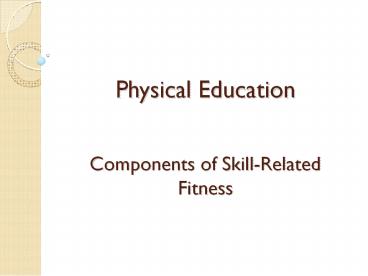Physical Education Components of Skill-Related Fitness - PowerPoint PPT Presentation
1 / 15
Title: Physical Education Components of Skill-Related Fitness
1
Physical EducationComponents of Skill-Related
Fitness
2
Task
- Define the terms
- Cardiovascular
- Muscular strength
- Muscular endurance
- Flexibility
- Body composition
- Know these inside out, ready for next exam!
3
Agility
The ability to change the position of the body
quickly and to control the movement of the whole
body
4
Agility
- Changing direction at speed
- Does not necessarily mean moving at
- speed
- Involves moving the body in different
- directions at speed
5
Balance
The ability to retain the centre of mass
(gravity) of the body above the base of support
with static or dynamic conditions of movement.
6
Balance
- Can be at rest or on the move
- Static balance is keeping the body still
- whilst stationary, e.g. a handstand
- Dynamic balance is maintaining a
- controlled stable condition whilst moving,
- e.g. basketball
7
Coordination
The ability to use two or more body parts together
8
Coordination
- Different types of coordination
- Hand-eye coordination (cricket,
- tennis, goalkeeper, etc.)
- Foot eye coordination (football,
- sprinting, skateboarding, etc.)
9
Power
The ability to undertake strength performance
quickly. Power Strength x Speed
10
Power
- Increases as a result of an increase in
- strength and speed
- Athletes use power to propel
- themselves and objects in a certain
- distance
- Do not get confused with muscular
- strength
11
Reaction Time
The time between the presentation of stimulus and
the onset of movement
12
Reaction Time
- Sight stimulus is the reaction in most
- sports (football, cricket, netball, etc.)
- It is possible to measure reactions
- and improve them through practise
- Anticipation from experience can also
- help reaction time
13
Speed
The rate at which a movement is performed or
distance is covered in a period of time
14
Speed
- Leg speed, e.g. Usain Bolt
- Arm speed, e.g. David Haye
- Speed of mind, e.g. Chong Wei Lee
- Can be improved with practise
15
Learning Objectives (Revisited)
- By the end of this lesson pupils should
- Recap health-related components of exercise
- and be able to use sports as examples
- Understand the components of skill-related
- exercise
- Be able to relate all these components to
- different physical activities

